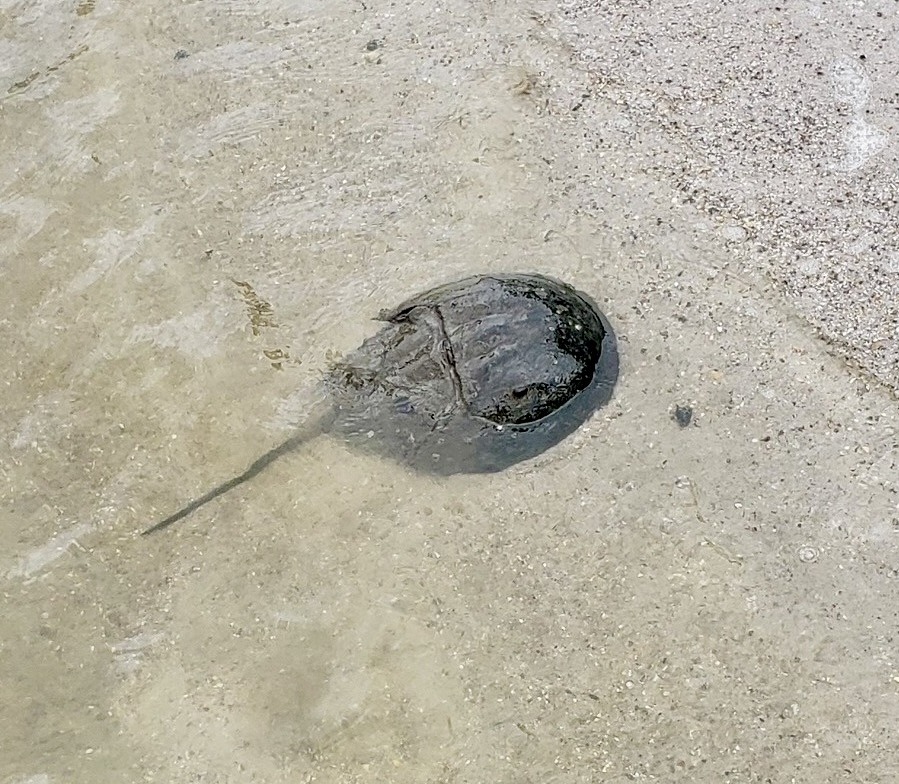
By Mary Reid Barrow
Picture this on Linkhorn Bay three months ago: 2500 square feet of eroding shoreline, the size of a tennis court, 1175 oyster castles, 200 tons of sand, 1000 marsh grass sprigs and almost 150 volunteer hours.
Now picture this: Oysters, barnacles and other critters growing on the oyster castles. Minnows and crabs at the water’s edge. Fresh green Spartina alternaflora grasses growing in a new sand beach, protected by fencing to keep the geese away.
One day recently Bert and Betsy Reese also were surprised to see a horseshoe crab, probably on an egg laying mission on their new living shoreline.
 |
 |
 |
“There’s always something going on,” said Bert, a retired executive with Sentara. “Crabs all over the place, big fish eating little fish.”
Had the Reeses chosen to restore their eroding shoreline with a bulkhead, there would be no horseshoe crab crawling out of the water and no habitat for oysters and other sea life.
The Reeses have lived in their home for more than two decades. Over the years, the property gradually eroded, Betsy said. but about three years ago, construction activity nearby accelerated the erosion drastically.
“It was all mud and a big, big drop off,” she explained. “We had to do something.”
Betsy, a retired nurse, said that doing the right thing was important to her. She grew up in Virginia Beach and feels a personal responsibility to take care of the river.
So, she decided to ask LRNow for help to restore her shoreline as it was meant to be. Her decision went back several years to a Landscape for Life class she took that was presented by LRNow and taught by landscape designer Trista Imrich. Participants learned to landscape their property with native plants suited to the habitat.
Before the class, Betsy worked hard to get plants to grow on their large, wooded lot and never had much success. But now with native plants, her yard is lush and healthy. That’s what she wanted for her shoreline too.
That led her to LRNow’s restoration coordinator, Vince Bowhers, who explained how a living shoreline project could protect the property from erosion and restore the vital wetlands habitat. The Reeses immediately knew that a living shoreline was their answer.
Vince connected them with Jim Cahoon, vice president and co-owner of Bay Environmental Inc., who designed a plan that would restore the shoreline to where it was when the Reeses purchased the property.
Jim supervised the installation, carried out by LRNow volunteers who were coordinated by Vince. The plan called for materials that could be delivered to the Reese shoreline with minimal damage to the beautiful intact marsh further inland and the upland native plant garden and woodlands.
To hold the shoreline Jim recommended the oyster castles, which are like Lego blocks made of oyster shells and crushed concrete, full of nooks and crannies that baby oysters will attach to. The castles were hand carried to the shore and put in place by volunteers.
 |
 |
Sand to fill in behind the oyster castles was brought in by barge and volunteers were recruited not only to spread the sand, but also to plant the grasses and erect the goose fencing.
Both Vince and Jim agree that engaging volunteers helps lower the overall cost of the project significantly and educates others in the community about the importance of living shorelines.
“It’s been an amazing project,” Betsy said. “We have had wonderful help. They even helped me clean the marsh!”

The result is the largest residential living shoreline that LRNow has ever been involved in and the largest private residential shoreline in the Lynnhaven River that Bay Environmental has ever completed.
“We are extremely fortunate to be able to see, first hand, every day, the good it is doing to our little spot,” Betsy said, “but in the big picture we can hope to be an example for continued restoration projects throughout our beautiful local waterways.”
For sure, the Reeses are setting an example for their younger grandchildren who visit their grandparents most weekends where minnow nets and fishing poles are waiting for them.
“We have eight little ones,” Besty said. “This is a paradise for them and I want them to learn how to care for it too.”
See the whole process here:
.